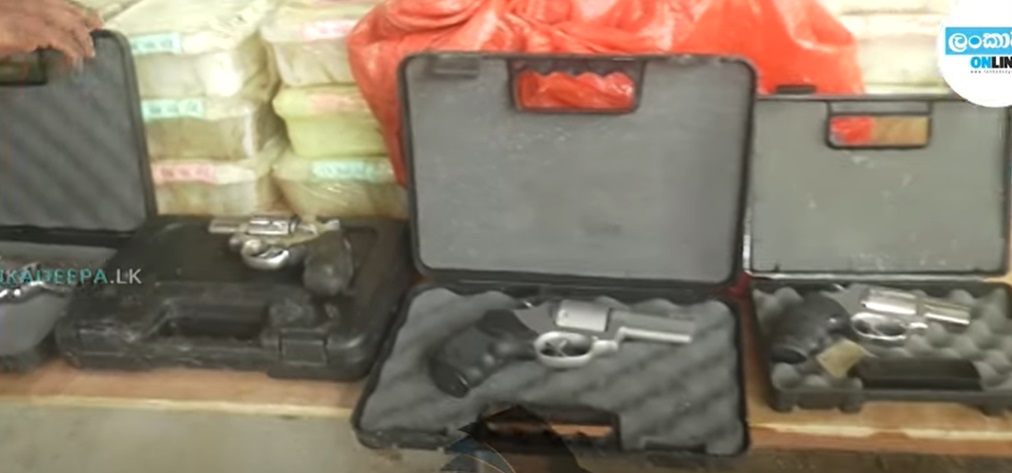-By LeN Security Correspondent

(Lanka-e-News - 22.Sep.2025, 11.10 PM) Hambantota and Tangalle — long considered the Rajapaksas’ political fiefdom — have now been confirmed as a central hub in Sri Lanka’s narcotics trade. Police in Tangalle today (22) seized more than 600 kilos of crystal methamphetamine (“ice”) and heroin, along with a cache of sophisticated firearms, from three lorries in the Seenimodara and Kadurupokuna areas.
The raids, conducted under the Tangalle Police Division, uncovered not only industrial-scale narcotics consignments but also modern weapons including T-56 assault rifles and revolvers stowed away in specially built compartments.
That such a vast haul of drugs and weaponry should emerge from a single district, and on a single day, is telling. What began as an investigation into three unexplained deaths has quickly unravelled into one of the most significant criminal seizures in recent memory.
The chain of events started with the purchase of an old house in Seenimodara. Its new owner, before renovations, had thrown a party for three acquaintances working on the property. By midnight, one guest — 50-year-old father of two, Thusitha Venuara Kumara from Lande Watta, Unakuruwa — fell suddenly ill. He was rushed to Tangalle Base Hospital, where he died by morning.
When police, alerted by his family, visited the house, they discovered two more corpses: those of 21-year-old Kavinda Kalhara of Lunama, Ambalantota, and 24-year-old Dinuka Lakshan Hewawitharana, also of Ambalantota. Both bodies were found near quantities of crystal meth.
Police believe the trio consumed narcotics at the party and died of overdose. But their deaths inadvertently opened the lid on a vast trafficking network. A lorry parked outside the property yielded ten packs of ice, each weighing a kilo. A second larger vehicle, with a concealed compartment, contained more than 200 kilos of ice and heroin. One of the lorries was registered to the deceased Kumara himself.
Acting on further intelligence, police raided a garage in Kadurupokuna, six kilometres away. Ostensibly stacked with honey melons, another lorry was found to contain 86 packs of ice, 100 packs of heroin, and an arsenal: a T-56 rifle and five brand-new revolvers, each tucked neatly into bespoke briefcase-style casings.
By dusk, the official tally of seizures stood at 245 kilos of heroin and 380 kilos of ice. “The total haul has surpassed 600 kilos,” confirmed Public Security Minister Ananda Wijepala at a press briefing, calling the discovery “a turning point” in the war on organised crime.
Investigations then led to Hambantota’s Middeyniya area, where two containers buried on land owned by SLPP strongman Sampath Manamperi were found to hold precursor chemicals for drug manufacture and hidden firearms.
Manamperi, arrested by the Narcotics Bureau, disclosed during interrogation that he had concealed yet another weapons cache on the property of a mistress. The search produced a bizarre mix: two gold-plated T-56 magazines, 115 rounds of ammunition, a hand grenade, and a damaged 9mm pistol.
Gold-plated T-56s are not new to Sri Lanka’s underworld; one was earlier recovered from a luxury apartment complex in Colombo.
Police also detained the husband of Manamperi’s mistress, an employee of the Ceylon Electricity Board, accused of harbouring the politician while he was on the run. Several bank cards were recovered in his possession.
What the seizures reveal is not merely a narcotics ring but the infrastructure of a parallel state: buried caches, weaponised lorries, political patronage. Hambantota and Tangalle, once portrayed as the Rajapaksas’ cradle of rural development, are now recast in the public eye as strongholds of trafficking and violence.
The government, keen to show muscle, highlighted the role of new 14,000 Public Security Committees established nationwide to aid police with intelligence gathering. Minister Wijepala argued that these committees, operating hand-in-hand with law enforcement, have produced an unprecedented flow of tips. “The people are giving us information, and we guarantee their safety,” he said.
But his words also carried an unspoken admission: that southern politicians, long shielded by patronage, are implicated in the very networks now being dismantled.
For the Rajapaksa dynasty, the symbolism is brutal. Hambantota’s international airport stands empty; its seaport was ceded to Beijing; and now its backstreets are described in police reports as the logistics base for narcotics and arms.
What was once marketed as the Rajapaksas’ “model district” of highways and stadiums is rebranded in the public imagination as a narco-fiefdom.
The irony is rich: the dynasty that built its reputation on law-and-order nationalism now watches as its strongholds are dragged into headlines as the country’s new Medellín.
-By LeN Security Correspondent
---------------------------
by (2025-09-22 18:24:25)
Leave a Reply